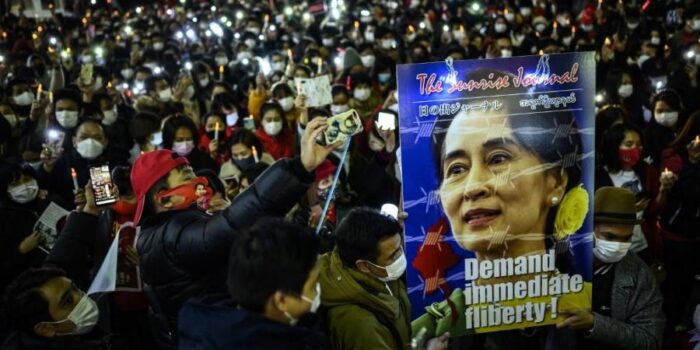
File Picture
Strange though it might seem, Myanmar, a province of the Indian colonial state till 1937 sharing 1600 km of land borders with Assam and Manipur ,a thriving trade as ” Burma rice” provided food security to Tea Labor and the region is now a distant neighbor of the north east. At present there are just two LCS- Land customs stations at Moreh in Manipur and Zowkhathar in Mizoram carrying on only 1.1% of Myanmar’s border trade of US$8465 Millions while her trade with other neighbours especially China and Thailand are booming as their shares in border trade in 2017-18 were 79.8% and 18.8% respectively.
This and other facts mentioned in the 2019 ICRIER study establish the reality that the much hyped Look and then Act East policy hasn’t really worked yet; because economic and infrastructural links are not in place for positioning NE firmly in the ASEAN economy which for us begins with Myanmar.
It’s indeed a ” chicken and egg” situation as strategic road connectivity is still not in place for forging ahead with trade and development. As for instance, only 40km of 110 km stretch of the road between Imphal and Tubul is two laned and the remaining portion of Imphal- Moreh road is single lane and subject to disruption during monsoon . The upgradation of Imphal-Jiribam sector under Bharat mala project is tardy. Similarly road conditions between Aizawl and Zowkhathar in Mizoram , the other LCS need early upgradation. Across Moreh the Friendship Road to link Moreh to Kyigone/ Kalewa in Sagaing Region of Myanmar and Mandalay is also not good because even after resurfacing and handing over the Kyigone -Kalewa section to Myanmar in 2009 ,the stretch beyond Kyigone and up to Mandalay is still bad as Myanmar has not been able to upgrade the road and construct 69 bridges critical for faster movement of traffic. Consequently, the ambitious IMT – India Myanmar Thailand Trilateral Highway project is still to be operationalized. The story of Kaladan multi nodal connectivity project to link North East and the Sittwee Port of Myanmar is about the same. This explains why only about1% of our US$1.06 billion merchandise trade with Myanmar in 2017-18 is ” border” trade, the rest being maritime.
From a broad South Asian perspective, separation of Burma under the Govt of India Act may be seen as the first ” Partition” of India preceding the 1947 division as together, it destroyed the vibrant Eastern regional economy encompassing East ,North east India , Myanmar and Bangladesh. .Act East policy is thus an unfinished effort to reconstruct the same.
The widespread and continuing agitation in Myanmar against the military coup notwithstanding, the view that the junta might be able to run the Myanmar state much like the way it ruled from 1962 till 2011 is not without basis. This is because even the colonial administrative system that Burma inherited as a part of India having features like separation of powers between the executive and judiciary and local self government had been so subverted over half a century of military rule that elected government under Madam Aung San Suu Kyi had to accept the blatantly wrong provisions of the 2008 Constitution which allow a) reservation of 25% of seats in the Central legislature for the Armed forces and b) placing internal security and External Affairs under the Armed forces and not the elected government. Both these provisions are violative of the basic principles of a democratic state based on the rule of law, as for instance, being government servants, the Armed forces personnel cannot be lawmakers because of ” conflict of interest”. And the aforementioned two subjects are central to governance and hence fall within the basic functions of any elected government.
Myanmar has thus been rightly put in the ” Authoritarian” category of states and ranked 135 in 2020 global democracy index of 167 countries – down from 110th rank in 2017 prepared annually by the Intelligence unit of London based Economist Newsmagazine. It is unfortunate that notwithstanding the “sanctions” of the West after Feb 1st coup and the emphatic verdict of the people in favor of NL D and leadership of Aung San Suu Kyi in Nov 2019 election, democracy in Myanmar even with all its deficiencies is unlikely to be restored in the near future for following reasons:
First , the unique history of the Armed forces of Myanmar emerging not from a professional colonial force as in Pakistan but from the BIA- Burma Independence Army under General Aung San formed during the second world war, first with the help of the Japanese occupation force and later the Allied forces which made it a part of the political power structure from the very beginning of Independence. It has even a political platform – Union Solidarity and Development Party USDP which contested the Nov 20 election and fared badly winning only 86 in the Lower House and 7 in Upper the House as compared to NLD’s tally of 285 and 138 seats in the respective Houses of the Legislature. Second, unending ethnic conflicts which began soon after Myanmar attained freedom from the British in 1948 reflect the failure of the dominant Barman ethnic group to accommodate the aspirations of diverse ” geopolitical minorities”, that is, ethnic groups such as the Karen, Kachin, Mon and Wa who constitute majority of the population of the provinces they inhabit even when they are minority groups in the total population.This position gives them an edge especially when such areas are border lands which explains why there are 17 such insurgent groups groups each having an Army like the Wa,Mon. and Kachin Armies and enjoy access to arms and logistics support from the neighborhood and especially in South China. Failure of Madam Aung San Suu Kyi to unite and make these ethnic groups stake holders is matched by her failure to deal effectively with the Covid 19 crisis and slow down of the economy. Myanmar therefore is all set to remain ” destabilized” with adverse consequence for the north east for two reasons: First, Assam, Nagaland and several other parts have been ” disturbed areas “for decades and facing insurgencies of varying intensity.
These insurgent groups operate from Myanmar border lands taking advantage of lack of effective control of the Myanmar government and receive logistics, arms ; indeed covert and overt Chinese support which are well documented in Bertil Lintner’s Great Game East . As the situation will now favor these groups it would obstruct implementation of the Act East policy and development of the region. Third, it would facilitate deepening of China’s political, economic and military engagement in Myanmar as China views Myanmar as the” strategic land bridge to the Bay of Bengal and the Indian ocean Region. China has already invested an estimated US$ 9 billion to develop a deep-sea Port at Kyaukphyu and operationalized the oil and gas pipe lines from there to Ruili in Yunan province of South China for transporting oil and gas from the middle East .This has enabled China to overcome her ” Malacca dilemma” that is over dependence on the Malacca straits for shipping of critical oil and gas imports.
China’s engagement with the Myanmar Army therefore will be long-standing. In fact, according to a 2011 Report of Stockholm based SIPRI China had been the major source of supplies of military hardware to Myanmar since 1988 covering 90% of military transport, warplanes, battle ships and provided training to the officer corps. All these created a base for the recent CMEC- China- Myanmar Economic Corridor designed to expand China Myanmar cooperation to a strategic level. In this scenario the official Chinese response to the Army coup that ” it’s an internal matter of Myanmar” suggests that China is willing to work with the junta as she did earlier.
What does this scenario suggest for the policy makers in the North East? A possible way out is to seek a viable alternative option to reach out to ASEAN. On this the prescient view of Late Purno Sangma, the legendary leader of the NE of national stature that ” for us in Meghalaya” look East ‘begins with looking at South, that is Bangladesh” makes strategic sense.
It is time Bangladesh is seen in the North East as an opportunity offered by her fast growing economy now firmly put in the category of” emerging economies” by the IMF for reaching out to ASEAN. For this, apart from gaining access to Chittagong Port it is also necessary to develop the region’s production function and especially its service sector in tune with the rising demand of Bangladesh market to revive the pre 1947 arrangements which served the eastern region so well. This is the real strategic challenge thrown up by the Feb 1 military coup in Myanmar. The impending visit of Prime Minister Modi to Bangladesh has much significance for the north east Region.
[the_ad id=’22722’]


















